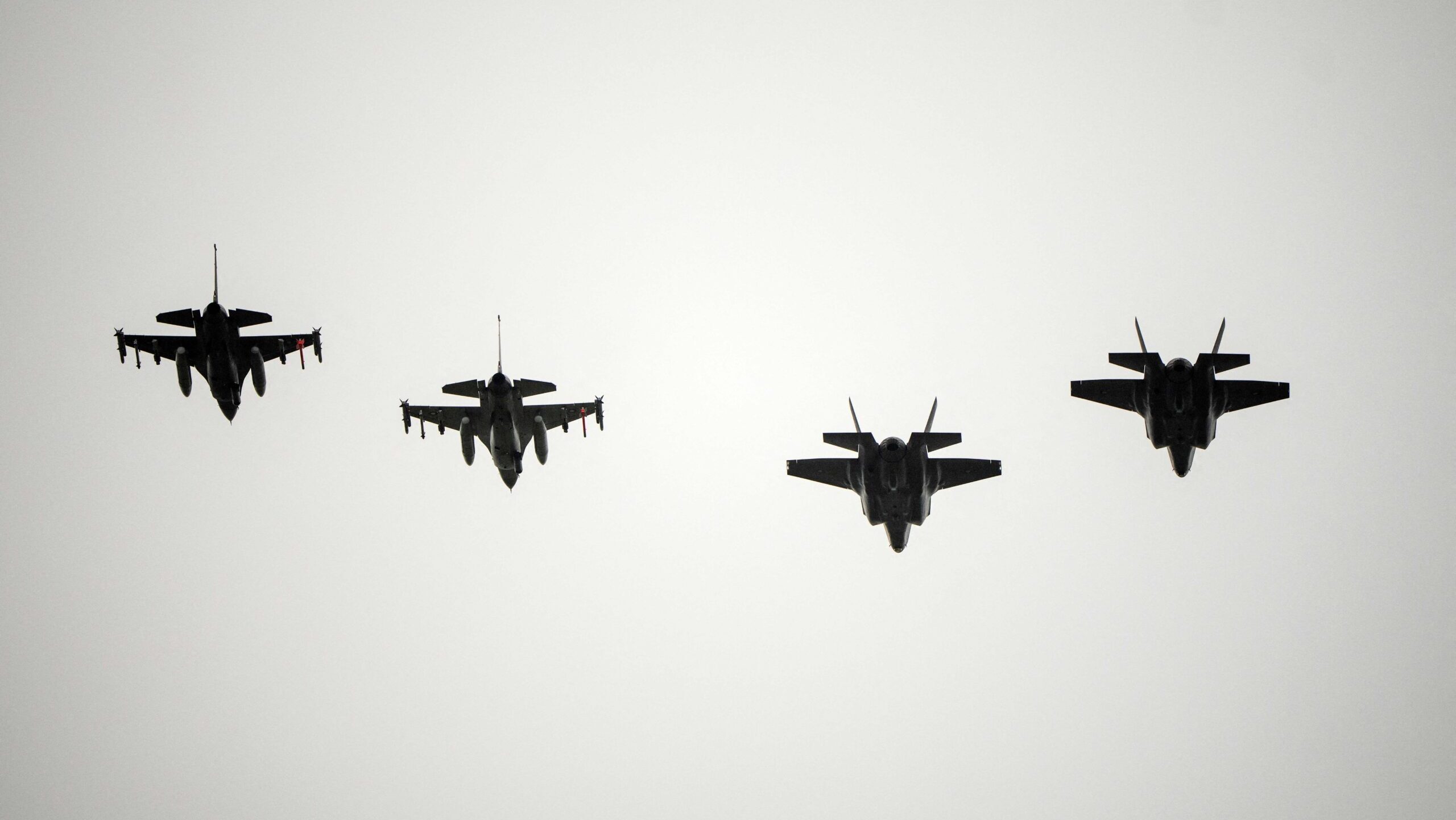
Two F-16 fighter jets (L) and two F-35 fighter jets fly as they return to Fighter Wing Skrydstrup air base of the Royal Danish Air Force (RDAF) after patrolling around Denmark at low altitude near Skrydstrup, Denmark on October 1, 2023. (Photo by BO AMSTRUP/Ritzau Scanpix/AFP via Getty Images)
WASHINGTON — After years of wrangling, Argentina and Denmark appear closer than ever to completing a deal for the South American nation to purchase a fleet of F-16s in what analysts said would be a boon not only for the Argentine Air Force (FAA) but for America in its competition with China across Latin America — should the deal go through.
It’s also likely to be a key topic of discussion as Gen. Laura Richardson, commander of US Southern Command, travels to Buenos Aires this week.
Days after Argentinian President Javier Milei suggested on social media that his country was buying the fighter jets, top defense officials from both countries met in Buenos Aires last week and signed a “letter of intent on the possible sale” of 24 F-16s.
El Ministro @luispetri y su par de Dinamarca @troelslundp firmaron una carta de intención para avanzar en la compra de las aeronaves F-16. La inversión en defensa vuelve a ser una prioridad. Estamos equipando a nuestras Fuerzas y recuperando la capacidad supersónica del país. pic.twitter.com/M75KLWBz1Q
— Ministerio Defensa (@MindefArg) March 26, 2024
Analyst Andrei Serbin Pont, president of the Argentine think tank CRIES, told Breaking Defense that if the sale goes through, the F-16s would “not only fulfill the needs of the [Argentine] Air Force but also recuperate other capabilities lost with the decommissioning of [Argentina’s] Mirage fleet” years ago.
But Milei had previously said that Argentina was not prioritizing military purchases, and Serbin Pont and other analysts warned that no deal is certain until the ink dries on a final contract — which local Danish media speculates could happen in Copenhagen later this month. Argentina’s Ministry of Defense did not respond to Breaking Defense’s request for comment for this report as of press time; Denmark’s MoD declined to comment.
Should the deal fall through for any reason, one key player will likely be especially disappointed: the US government.
The State Department approved the transfer of the US-made F-16s back in October and was quick to praise Milei’s suggestions online last week that it was happening. More recently, USSOUTHCOM’s Richardson announced her visit Buenos Aires “to discuss the longstanding defense partnership.”
We welcome President Milei's statement earlier this week that Argentina 🇦🇷 will purchase second-hand 🇺🇸US-built F-16 fighter jets from Denmark 🇩🇰 that offers @FuerzaAerea_Arg a low cost high performance multirole aircraft. pic.twitter.com/10VahifwH7
— Political-Military Affairs, US Dept of State (@StateDeptPM) March 22, 2024
The US has identified Argentina’s fighter jet acquisition as one front in its global competition with China, as Buenos Aires was also considering the Sino-Pakistani CAC/PAC JF-17 Thunder or India’s HAL Tejas fighter jets to replace its Mirages.
Breaking Defense reported in September that a former Defense Department analyst said a Chinese fighter jet in Argentina would not be a threat to the US on its own, but be a “camel’s nose under the tent” that could lead to more Chinese influence in Buenos Aires and the region.
Jakob Linnet Schmidt, an analyst at the Danish Institute for International Studies, said it may seem a “surprise” the jets aren’t instead heading for Ukraine, considering Europe’s pledge to provide just such airframes to Kyiv and Washington’s support for arming their Eastern European partner against Russia’s invasion.
But officials previously told Breaking Defense that Denmark can do both, and Schmidt said that by working with Argentina, Copenhagen is working in concert with US interests.
One final issue to consider is the condition of the F-16s. In 2018 Argentina bought five refurbished Dassault-Breguet Super Étendard warplanes from France for its Navy. However, none were reportedly airworthy, prompting a scandal in Buenos Aires.
“As far as I know, the Danish F-16s are in good condition and could fly for an additional decade or so, thus creating a bilateral cooperation between the US and Argentina for years to come,” Schmidt said.
In addition to the potential F-16 buy, and despite Milei’s austerity call, Argentina appears in the market for other key aircraft. In September Buenos Aires signed an agreement with Norway to purchase four used Lockheed P-3 Orion maritime surveillance aircraft (MPAs). The Milei administration has reportedly issued the first payment of $10 million USD.
This project is not new, as Serbin Pont said the negotiations reach back through three administrations. Illegal, unreported, or unregulated fishing is a security challenge for Argentina as vast fishing fleets, primarily allegedly from China, operate across the South Atlantic. Hence, “the P-3 is a central component of the capabilities that the Navy seeks to regain,” Serbin Pont said.
Australia tops up Ukraine military aid with $100M
Australia has already supplied Ukraine with 120 Bushmaster vehicles, six 155mm howitzers, 56 M113 armored vehicles, 14 special operations vehicles and its signature cardboard drones.



























